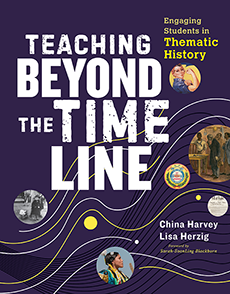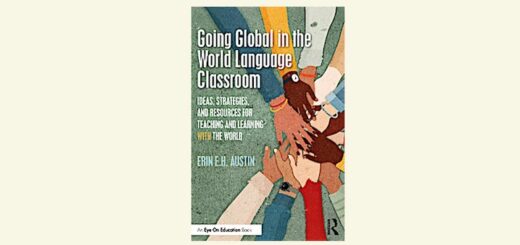Reach Past the Timeline with Thematic History
Teaching Beyond the Timeline: Engaging Students in Thematic History
By China Harvey and Lisa Herzig
(Heinemann, 2024 – Learn more)
Reviewed by Sarah Cooper

In my own eighth-grade U.S. history and civics classes, I’ve happily taught thematic history for a decade now. We cover current events with a media literacy lens, political history through founding documents, social history with a reformers unit, and wartime history through personal stories.

This carefully crafted book, co-authored by two high school social studies teachers, will expand any teacher’s repertoire and inspire us to ask ourselves: How can we make history more relevant, exciting and connected to the present for our students?
Harvey and Herzig’s yearlong theme is “Striving for Liberty and Equality,” and they give examples of other options such as “A More Perfect Union” and “10 Most Important Events in U.S. History.” If overhauling your course sounds overwhelming, the authors offer suggestions to weave in the connective critical thinking that a thematic course encourages.
Teachers can select a “course-long theme that runs throughout each of your more traditional, chronological units,” move or tweak existing favorite lessons, or “begin each unit with a current event” to pique interest and show impact. As the authors observe, “imagine how engaged students will be if you start the unit with a topic that is relevant to them, then have them engage in inquiry to uncover the past.”
In other words, there’s something here for everyone.
Easy to Follow Along
This book “is meant to be both informational and a workbook,” and graphic organizers throughout (reprinted helpfully in the appendix) lead teachers through crafting a central theme, big-picture question, unit-level themes, unit-level focus questions, lesson plans, summative assessments and more.
Reading Teaching Beyond the Timeline truly feels like the best kind of professional development course: packed with information, responsive to who we are as learners and anticipatory of our needs. The authors ask us questions to illuminate what we care about as teachers, then give us the tools to turn these passions into daily lesson plans that build upon and talk to each other.
The four essential ingredients of a thematic course for Harvey and Herzig are:
- Identifying Your Motivation (knowing your personal why as a teacher)
- Engaging Through Current Events (starting each unit with a news story that carries us back in time)
- Centering Identity and Inclusion (responding to the histories and cultures of the learners who surround us)
- Using an Inquiry-Based Approach (connecting historical periods to see impacts over time)
What About Chronology and State Standards?
Sometimes thematic teaching gets dismissed as being “less rigorous” than a chronological approach. Over and over again, Teaching Beyond the Timeline debunks this fallacy. For instance, in a section on Creating Engaging and Relevant Thematic Assessments, the authors insist: “Our job as history teachers is to ensure students learn history! Therefore, each assessment should require students to ground their responses in historical evidence” and “ask students to use skills of historical inquiry.” (Italics mine).
Far from discounting chronology, the authors’ approach integrates it impressively in various lessons, often including a short video clip to span the time period while also analyzing primary sources. By the end of the year, Harvey and Herzig find that “students have an even better grasp of chronology using the thematic approach because the course of U.S. history is covered multiple times during the year through a series of different lenses.”
Just as I was wondering how the authors incorporate state requirements, they included several pages on mapping out a unit to embed necessary standards – which, in a thematic course, may end up being taught out of order.
Their immigration unit’s focus questions are “To what extent has U.S. immigration policy afforded newcomers with rights to liberty and equality?” and “How have migrants from Europe, Asia, Africa, and the Americas agitated, advocated, and demanded the United States to embody these founding ideals?”
The graphic organizer for this unit lists Topics/Standards to Address including “Push and pull factors (CA 11.2)” and “Anti-Catholic nativism (CA 11.3.3),” then adds Specific Developments to Address such as The Geary Act of 1892, the Great Migration, and Fred Korematsu and Mitsuye Endo.
The nuance of combining these standards and specific details wowed me – such a curated list creates a robust and memorable unit that students will remember. Relatedly, the chapters on creating “broad” and “narrow” chronological lessons (Chapter 5: Broad Time Period Lesson on Voting Rights [approx. 1865-2013] and Chapter 6: Thematic Teaching in Action: Narrow Time Period Lesson on Women and the War Effort [World War II]) finally put a name to a distinction I’ve made for a long time but never articulated so clearly.
Creating Responsible Citizens
Interspersed throughout the book are comments from teachers and students about how this thematic approach has empowered them to understand themselves and their country better. I loved hearing about this personal impact: “My parents and I are in awe of how amazing this course is because of how it teaches the real history and represents everyone.”
In addition, the authors take pains to emphasize that “we want to avoid telling the class what to think” but rather ask students to “practice how to think by using an array of evidence to support their claims.”
I could go on about the many zinger moments in Teaching Beyond the Timeline that made me want to replan some of my units right now and test them out on real students, even though it’s still summer!
Really, though, you need to experience the book’s friendly intricacy for yourself – and then buy it for every preservice, new and veteran social studies teacher you know.
Sarah J. Cooper teaches eighth-grade U.S. History and is Associate Head of School at Flintridge Prep in La Canada, California, where she has also taught English Language Arts. Sarah is the author of Making History Mine (Stenhouse, 2009) and Creating Citizens: Teaching Civics and Current Events in the History Classroom (Routledge, 2017). She presents at conferences and writes for a variety of educational sites. You can find all of Sarah’s writing at sarahjcooper.com.


































